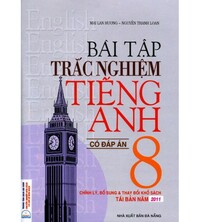2.7 - Unit 2. Wild nature - SBT Tiếng Anh 8 English Discovery
1 Complete the names of the disasters in the pictures and cross out one option that does not describe each picture. 2 Below is a report about a natural disaster in Japan. Choose a suitable sentence to fill in each blank. 3 Read the sample writing in Exercise 2 once again and complete. 4 Here are some useful words/phrases / sentences to write a report about a typhoon. Put it in the correct part of the report.
Bài 1
1 Complete the names of the disasters in the pictures and cross out one option that does not describe each picture.
(Hoàn thành tên của các thảm họa trong hình và gạch bỏ một tùy chọn không mô tả mỗi hình.)

1 d t
a low rainfall
(lượng mưa thấp)
b water shortage
(thiếu nước)
c shaking
(lắc)
2 ar q
a epicenter
(tâm chấn)
b floods
(lũ lụt)
c damage to building
(thiệt hại cho tòa nhà)
3 h n
a strong winds
(cơn gió mạnh)
b low rainfall
(lượng mưa thấp)
c bad injuries
(thiệt hại nặng)
4 un i
a heavy rain
(cơn mưa lớn)
b epicenter
(tâm chấn)
c bad injuries
(thiệt hại nặng)
Lời giải chi tiết:
1 drought
(hạn hán)
c shaking
(lắc)
2 earthquake
(động đất)
b floods
(lũ lụt)
3 hurricane
(bão lốc xoáy)
b low rainfall
(lượng mưa thấp)
4 tsunami
(sóng thấn)
b epicenter
(tâm chấn)
Bài 2
2 Below is a report about a natural disaster in Japan. Choose a suitable sentence to fill in each blank.
(Dưới đây là báo cáo về một thảm họa thiên nhiên ở Nhật Bản. Chọn câu thích hợp điền vào mỗi chỗ trống.)
. A massive earthquake took place 72 kilometers to the east of Tohoku region in Japan in 2011. Because the epicenter was quite close to Japanese land, powerful tsunami waves with the height up to 40 meters hit the eastern coast of Japan in just a few minutes. . Many people were badly injured. Some did not even survive because they could not find a high place to hide away. .Moreover, it took away nearly 20,000 deaths and injured more than 6,000 people. .
A The tsunami caused a great shortage of water and great damage to houses, buildings and transportation
(Sóng thần gây ra tình trạng thiếu nước nghiêm trọng và thiệt hại lớn về nhà cửa, công trình và giao thông)
B After the disaster, volunteers from Japan and many other countries came here to support people with food, clothes and medical aid
(Sau thảm họa, các tình nguyện viên từ Nhật Bản và nhiều quốc gia khác đã đến đây để hỗ trợ người dân lương thực, quần áo và viện trợ y tế)
C A decade ago, Japan experienced the worst tsunami ever in history
(Một thập kỷ trước, Nhật Bản trải qua trận sóng thần tồi tệ nhất trong lịch sử)
D The strong flood destroyed everything on its way, even some of the biggest buildings.
(Trận lũ lớn đã phá hủy mọi thứ trên đường đi của nó, kể cả một số tòa nhà lớn nhất)
Lời giải chi tiết:
C- A decade ago, Japan experienced the worst tsunami ever in history. A massive earthquake took place 72 kilometers to the east of Tohoku region in Japan in 2011. Because the epicenter was quite close to Japanese land, powerful tsunami waves with the height up to 40 meters hit the eastern coast of Japan in just a few minutes. D- The strong flood destroyed everything on its way, even some of the biggest buildings. Many people were badly injured. Some did not even survive because they could not find a high place to hide away. A- The tsunami caused a great shortage of water and great damage to houses, buildings and transportation. Moreover, it took away nearly 20,000 deaths and injured more than 6,000 people. B After the disaster, volunteers from Japan and many other countries came here to support people with food, clothes and medical aid.
(Một thập kỷ trước, Nhật Bản đã trải qua trận sóng thần tồi tệ nhất trong lịch sử. Một trận động đất lớn xảy ra cách khu vực Tohoku của Nhật Bản 72 km về phía Đông vào năm 2011. Do tâm chấn khá gần đất liền Nhật Bản nên những đợt sóng thần mạnh có chiều cao lên tới 40m đã ập vào bờ biển phía Đông Nhật Bản chỉ trong ít phút. Trận lũ lớn đã phá hủy mọi thứ trên đường đi của nó, ngay cả một số tòa nhà lớn nhất. Nhiều người bị thương nặng. Một số thậm chí không sống sót vì không tìm được chỗ cao để trốn. Trận sóng thần gây ra tình trạng thiếu nước nghiêm trọng và thiệt hại lớn về nhà cửa, công trình và giao thông vận tải. Hơn nữa, nó đã cướp đi gần 20.000 người chết và hơn 6.000 người bị thương. Sau thảm họa, các tình nguyện viên từ Nhật Bản và nhiều quốc gia khác đã đến đây để hỗ trợ người dân lương thực, quần áo và viện trợ y tế.)
Bài 3
3 Read the sample writing in Exercise 2 once again and complete.
(Đọc lại bài viết mẫu ở bài tập 2 và hoàn thành.)
1 What is the natural disaster?
(Thảm họa thiên nhiên đó là gì?)
.
2 Where and when did it happened?
(Nó xảy ra ở đâu và khi nào?)
.
3 What happened?
(Điều gì đã xảy ra?)
.
4 What are the effects of this disaster?
(Hậu quả của thảm họa này là gì?)
.
5 What have been done to help victims of the disaster?
(Những gì đã được thực hiện để giúp đỡ các nạn nhân của thảm họa?)
.
Lời giải chi tiết:
1 It is tsunami.
(Đó là sóng thần.)
2 It happened about a decade ago in Japan.
(Nó xảy ra khoảng một thập kỷ trước ở Nhật Bản.)
3 A massive earthquake took place 72 kilometers to the east of Tohoku region in Japan in 2011. Because the epicenter was quite close to Japanese land, powerful tsunami waves with the height up to 40 meters hit the eastern coast of Japan in just a few minutes.
(Một trận động đất lớn diễn ra cách khu vực Tohoku của Nhật Bản 72 km về phía đông vào năm 2011. Do tâm chấn khá gần đất liền Nhật Bản nên những đợt sóng thần mạnh có chiều cao lên tới 40 mét đã ập vào bờ biển phía đông Nhật Bản chỉ trong vài phút .)
4 The strong flood destroyed everything on its way, even some of the biggest buildings. Many people were badly injured. The tsunami caused a great shortage of water and great damage to houses, buildings and transportation. Moreover, it took away nearly 20,000 deaths and injured more than 6,000 people.
(Trận lụt lớn đã phá hủy mọi thứ trên đường đi của nó, ngay cả một số tòa nhà lớn nhất. Nhiều người bị thương nặng. Sóng thần gây ra tình trạng thiếu nước nghiêm trọng và thiệt hại lớn về nhà cửa, công trình và giao thông. Hơn nữa, nó đã cướp đi gần 20.000 người chết và hơn 6.000 người bị thương.)
5 After the disaster, volunteers from Japan and many other countries came here to support people with food, clothes and medical aid.
(Sau thảm họa, các tình nguyện viên từ Nhật Bản và nhiều quốc gia khác đã đến đây để hỗ trợ người dân lương thực, quần áo và viện trợ y tế.)
Bài 4
4 Here are some useful words/phrases / sentences to write a report about a typhoon. Put it in the correct part of the report.
(Dưới đây là một số từ/cụm từ/câu hữu ích để viết báo cáo về một cơn bão. Đặt nó vào đúng phần của báo cáo.)

Từ vựng:
took place in: đã diễn ra trong
strong winds: Gió to
damage to houses and buildings: thiệt hại cho nhà cửa và các tòa nhà
power cut: cắt điện
many deaths: nhiều cái chết
many people became homeless: nhiều người trở thành vô gia cư
provide support: cung cấp hỗ trợ
volunteers: tình nguyện viên
bad injures: vết thương nặng
heavy rain: mưa nặng hạt
floods: lũ lụt
last year: năm ngoái
medical aid: viện trợ về y tế
1 What is the natural disaster?
(Thảm họa thiên nhiên là gì?)
Typhoon
(bão nhiệt đới)
2 Where and when did it happened
(Nó xảy ra ở đâu và khi nào?)
3 What happened?
(Điều gì đã xảy ra?)
4 What are the effects of this disaster?
(Hậu quả của thảm họa này là gì?)
5 What have been done to help victims of the disaster?
(Những gì đã được thực hiện để giúp đỡ các nạn nhân của thảm họa?)
Lời giải chi tiết:
2 It took place last year in Japan.
(It took place last year in Japan.)
3 Heavy rains lasted for hours along with strong winds. They caused floods all over Kyoto city.
(Những cơn mưa lớn kéo dài hàng giờ cùng với những cơn gió to. Chúng đã gây lên lũ lụt ở khắp thành phố Kyoto.)
4 The typhoon destroyed everything on its way, even some of the biggest buildings. Many people were badly injured. The typhoon caused power cut and great damage to houses, buildings. Moreover, it made many deaths and many people became homeless.
(Cơn bão đã phá hủy mọi thứ trên đường đi của nó, ngay cả một số tòa nhà lớn nhất. Nhiều người bị thương nặng. Bão gây mất điện và thiệt hại lớn về nhà cửa, công trình. Hơn nữa, nó đã khiến nhiều người chết và nhiều người trở thành vô gia cư.)
5 After the disaster, volunteers from Japan and many other countries came here to support people with food, clothes and medical aid.
(Sau thảm họa, các tình nguyện viên từ Nhật Bản và nhiều quốc gia khác đã đến đây để hỗ trợ người dân lương thực, quần áo và viện trợ y tế.)
Bài 5
5 Write a paragraph (80-100 words) to report about a natural disaster in Việt Nam in recent years.
(Viết một đoạn văn (80-100 từ) để báo cáo về một thiên tai ở Việt Nam trong những năm gần đây.)
Lời giải chi tiết:
In recent years, Vietnam has suffered from severe natural disasters, especially in the central region. Two major floods have left people in the Central region homeless. They lost all their possessions and had no food. Volunteers are ready to help people with clothes, food and money.
(Những năm gần đây, Việt Nam phải chịu những đợt thiên tai rất nặng nề, đặc biệt là tại khu vực miền Trung. Hai cơn lũ lụt lớn đã khiến người dân miền Trung không còn nhà ở. Họ bị mất hết tài sản và không có đồ ăn. Những tình nguyện viện đã sẵn sàng để cứu trợ người dân cùng với quần áo, đồ ăn và tiền.)
Search google: "từ khóa + timdapan.com" Ví dụ: "2.7 - Unit 2. Wild nature - SBT Tiếng Anh 8 English Discovery timdapan.com"







